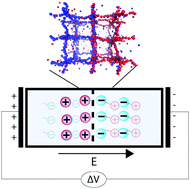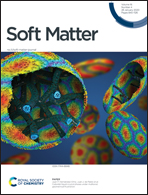Poisson–Boltzmann modeling and molecular dynamics simulations of polyelectrolyte gel diodes in the static regime
Abstract
We present molecular dynamics (MD) simulations of a model polyelectrolyte gel diode formed by a junction of two oppositely charged crosslinked polyelectrolyte networks, and compare the ion densities and electrostatic field to a corresponding continuum Poisson–Boltzmann (PB) model. At low electrostatic coupling strength (i.e. low Bjerrum lengths), the PB model reproduces the MD simulation results for density and electric field throughout the gel very well. At higher electrostatic coupling (i.e. large Bjerrum lengths) and higher degrees of ionization, the standard PB fails to predict the MD profiles at the diode interface due to counterion condensation, network collapse and field-induced gel deformation. In fact MD simulations predict that the rectifying behavior of diodes operating in such regimes will be much reduced. We develop a modified PB model that accounts for these effects, and show that it produces better agreement with the MD results. The updated PB model can be used for improved modeling of experimental results on PE gel diodes.



 Please wait while we load your content...
Please wait while we load your content...